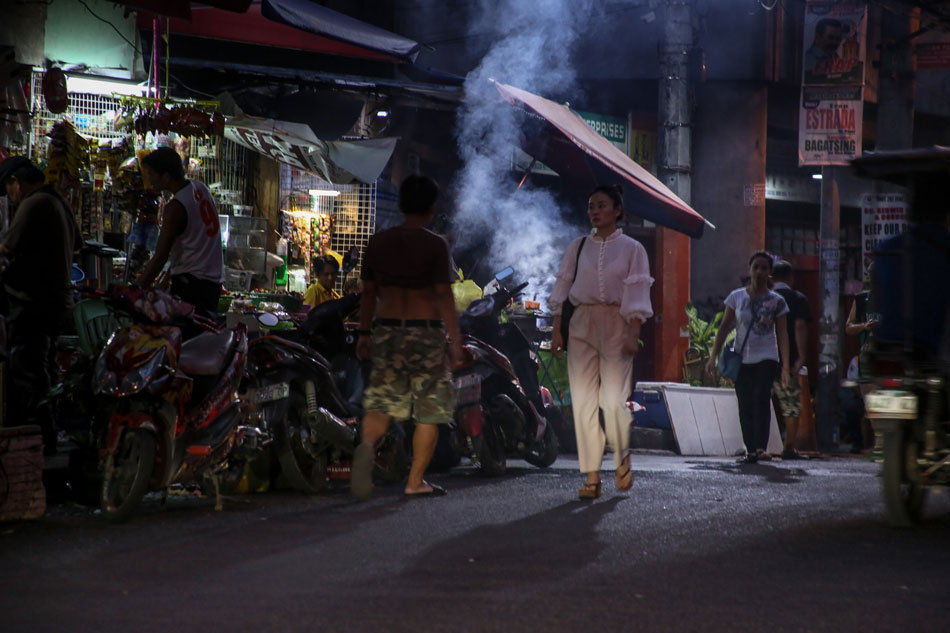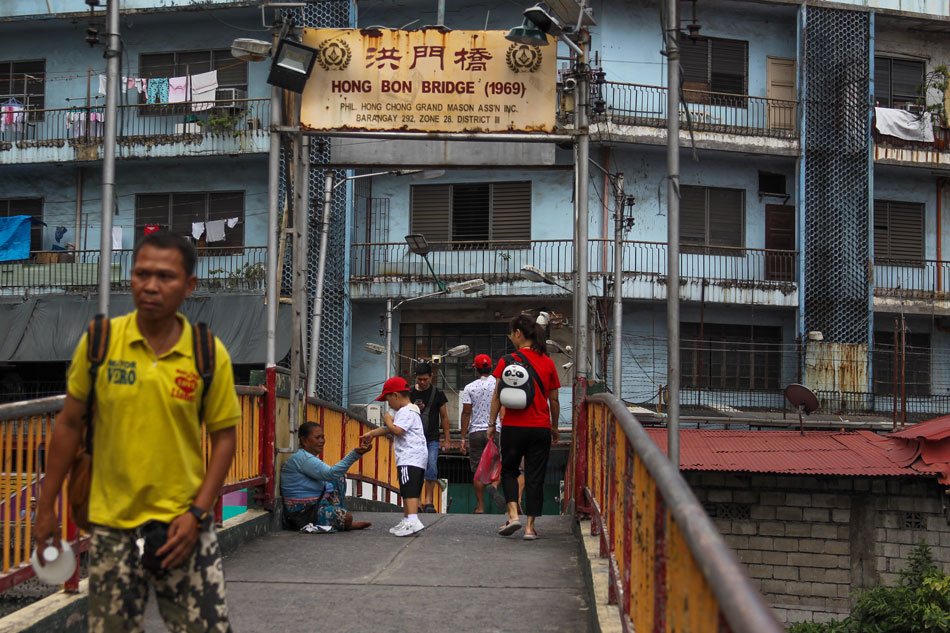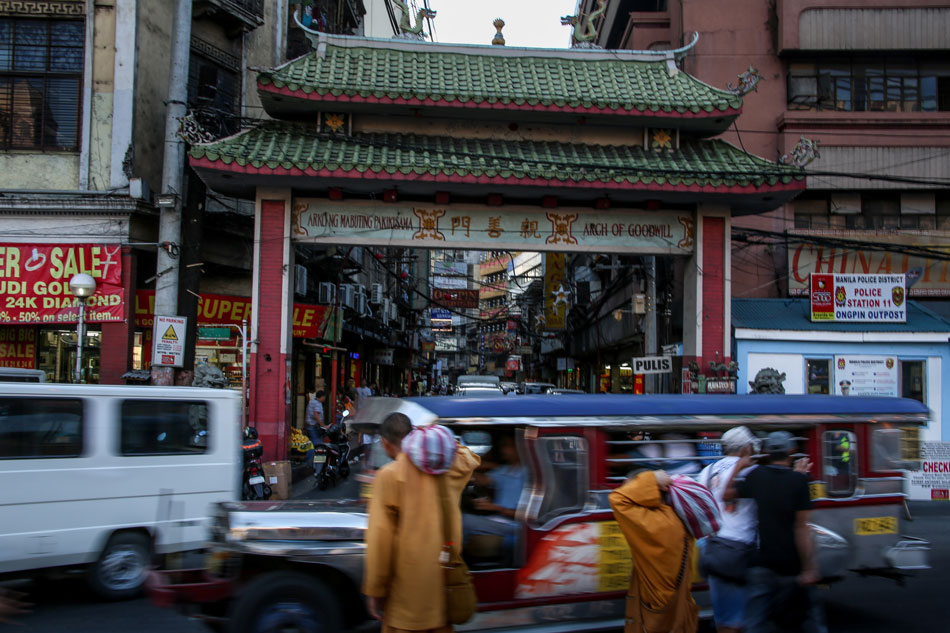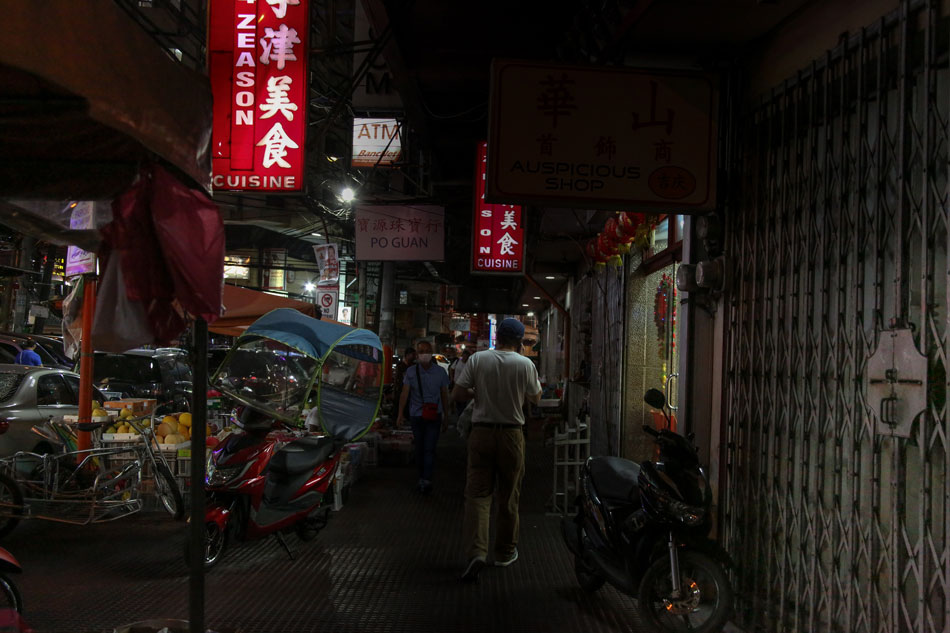Kidnapping of Tsinoys gone, but community remains vigilant | ABS-CBN

Welcome, Kapamilya! We use cookies to improve your browsing experience. Continuing to use this site means you agree to our use of cookies. Tell me more!
Kidnapping of Tsinoys gone, but community remains vigilant
Kidnapping of Tsinoys gone, but community remains vigilant
Michael Joe Delizo,
ABS-CBN News
Published Jul 06, 2019 11:43 AM PHT
|
Updated Jul 06, 2019 04:22 PM PHT
First of two parts
MANILA — Decades ago, abductions of Chinese-Filipinos by kidnap syndicates were commonplace in the Philippines.
MANILA — Decades ago, abductions of Chinese-Filipinos by kidnap syndicates were commonplace in the Philippines.
“Every week, there was a kidnapping,” said Maj. Gen. Guillermo Eleazar, a former member of the Police Anti-Crime and Emergency Response unit and now chief of the National Capital Region Police Office.
“Every week, there was a kidnapping,” said Maj. Gen. Guillermo Eleazar, a former member of the Police Anti-Crime and Emergency Response unit and now chief of the National Capital Region Police Office.
Filipino kidnap gangs preyed on those of Chinese descent, known to be moneyed and averse to reporting to authorities.
Filipino kidnap gangs preyed on those of Chinese descent, known to be moneyed and averse to reporting to authorities.
In the words of anti-crime advocate Teresita Ang-See, they were the “perfect victims.”
In the words of anti-crime advocate Teresita Ang-See, they were the “perfect victims.”
ADVERTISEMENT
“The height of kidnapping was mainly because the Chinese-Filipinos were perfect victims. They keep quiet, they don’t report, they don’t cooperate, they pay the ransom, they pay the ransom big, they pay the ransom fast,” she said.
“The height of kidnapping was mainly because the Chinese-Filipinos were perfect victims. They keep quiet, they don’t report, they don’t cooperate, they pay the ransom, they pay the ransom big, they pay the ransom fast,” she said.
But not anymore. Police say the kidnap gangs which targeted Tsinoys have been quelled, although Chinese-Filipinos remain vigilant.
But not anymore. Police say the kidnap gangs which targeted Tsinoys have been quelled, although Chinese-Filipinos remain vigilant.
Eleazar said the gangs, mostly from Eastern Visayas, "are now all gone.”
Eleazar said the gangs, mostly from Eastern Visayas, "are now all gone.”
“We were already able to neutralize them,” he said.
“We were already able to neutralize them,” he said.
Eleazar believes remnants of these kidnap-for-ransom groups have shifted to other activities, likely in the illegal drug trade.
Eleazar believes remnants of these kidnap-for-ransom groups have shifted to other activities, likely in the illegal drug trade.
ADVERTISEMENT
"‘Yung grupo noon, wala na. Tapos na iyon. Kung mayroon mang lumutang ngayon, mga nag-emerge na new groups, nangyari kasi after ma-neutralize ang grupo, may ilang galamay na natitira na nage-experiment uli sila."
"‘Yung grupo noon, wala na. Tapos na iyon. Kung mayroon mang lumutang ngayon, mga nag-emerge na new groups, nangyari kasi after ma-neutralize ang grupo, may ilang galamay na natitira na nage-experiment uli sila."
(The groups before, they're gone. That's over. If there are some that surface now, emerging new groups, that happens after we neutralize the main group, some remnants are experimenting again.)
(The groups before, they're gone. That's over. If there are some that surface now, emerging new groups, that happens after we neutralize the main group, some remnants are experimenting again.)
Philippine National Police (PNP) Spokesperson Police Col. Bernard Banac said that in general, Chinese-Filipinos are now safe.
Philippine National Police (PNP) Spokesperson Police Col. Bernard Banac said that in general, Chinese-Filipinos are now safe.
Things are now different.
Things are now different.
“Generally, the security of Filipino-Chinese is very good,” Banac said.
“Generally, the security of Filipino-Chinese is very good,” Banac said.
ADVERTISEMENT
“We intensified our campaign against criminality. We also have a campaign against kidnap-for-ransom groups and private armed groups, we combated them simultaneously.”
“We intensified our campaign against criminality. We also have a campaign against kidnap-for-ransom groups and private armed groups, we combated them simultaneously.”
Kidnappings of mostly Filipino-Chinese victims hogged headlines in the '90s, the heyday of kidnap-for-ransom groups.
Kidnappings of mostly Filipino-Chinese victims hogged headlines in the '90s, the heyday of kidnap-for-ransom groups.
In her book Chinese in the Philippines Volume V, Ang See said an estimated 140 Filipino-Chinese were killed by kidnap-for-ransom syndicates from 1993 until about 2018, when the book was published.
In her book Chinese in the Philippines Volume V, Ang See said an estimated 140 Filipino-Chinese were killed by kidnap-for-ransom syndicates from 1993 until about 2018, when the book was published.
The number does not include kidnapping incidents that may have not been reported, and many unknown cases may have occurred outside Metro Manila.
The number does not include kidnapping incidents that may have not been reported, and many unknown cases may have occurred outside Metro Manila.
Among the prominent cases were the 2003 abduction of University of the Philippines graduate Betty Chua Sy. She was killed by kidnappers involved in at least 15 previous cases.
Among the prominent cases were the 2003 abduction of University of the Philippines graduate Betty Chua Sy. She was killed by kidnappers involved in at least 15 previous cases.
ADVERTISEMENT
Businessman Benito Chao, 69, was kidnapped in Caloocan City on his way home from his umbrella factory late evening of Aug. 27, 2014. Negotiations for his release lasted until past midnight.
Businessman Benito Chao, 69, was kidnapped in Caloocan City on his way home from his umbrella factory late evening of Aug. 27, 2014. Negotiations for his release lasted until past midnight.
No other calls were received the day after, until his body was found in Sta. Maria, Bulacan, about 30 kilometers from Caloocan.
No other calls were received the day after, until his body was found in Sta. Maria, Bulacan, about 30 kilometers from Caloocan.
COMMUNITY STILL WARY ABOUT SAFETY
At 28, Kevin Joshua Ng still gets restrictions from his parents over security concerns. He grew up with “rigid” rules and limits on the places he visits and times he goes out, and he was not allowed to wear his ID and uniform outside school.
At 28, Kevin Joshua Ng still gets restrictions from his parents over security concerns. He grew up with “rigid” rules and limits on the places he visits and times he goes out, and he was not allowed to wear his ID and uniform outside school.
Ng knows that having Chinese blood in the Philippines is risky. They are perceived as moneyed and remain targets of kidnap and robbery gangs.
Ng knows that having Chinese blood in the Philippines is risky. They are perceived as moneyed and remain targets of kidnap and robbery gangs.
In college, Ng and his younger brother, who both have prominent Chinese features, went through their own ordeal.
In college, Ng and his younger brother, who both have prominent Chinese features, went through their own ordeal.
ADVERTISEMENT
“We were swindled,” Ng said.
“We were swindled,” Ng said.
He narrated: “We were about to get a ride in front of SM Sta. Mesa. It was scary, we were cornered by 4 men asking about our personal information, ‘Where do you study?’ Then one of them left their thing with us to get our trust and meet someone at a certain place.”
He narrated: “We were about to get a ride in front of SM Sta. Mesa. It was scary, we were cornered by 4 men asking about our personal information, ‘Where do you study?’ Then one of them left their thing with us to get our trust and meet someone at a certain place.”
In exchange, the Ngs also gave their bags to the men and agreed for a meet-up but none of the men showed up.
In exchange, the Ngs also gave their bags to the men and agreed for a meet-up but none of the men showed up.
Entrepreneur and journalist Wilson Lee Flores said that the Chinese in general are practical, but that some are also easy to negotiate with. He surmised that the Chinese are also stereotyped in the Philippines as being well-off, making them targets of criminals.
Entrepreneur and journalist Wilson Lee Flores said that the Chinese in general are practical, but that some are also easy to negotiate with. He surmised that the Chinese are also stereotyped in the Philippines as being well-off, making them targets of criminals.
Flores, who also has Chinese blood, admitted that he takes personal precautions.
Flores, who also has Chinese blood, admitted that he takes personal precautions.
ADVERTISEMENT
“Number 1, I don’t pass [through] weird or small roads. I don’t take shortcuts. Baka masiraan ako sa daan na weird, na walang katao-katao. May fear pa rin,” he said.
“Number 1, I don’t pass [through] weird or small roads. I don’t take shortcuts. Baka masiraan ako sa daan na weird, na walang katao-katao. May fear pa rin,” he said.
(My car might break down on a weird road, where nobody is there. There is still fear.)
(My car might break down on a weird road, where nobody is there. There is still fear.)
In the Chinese-dominated district of Binondo, the world's oldest Chinatown, about 300 police officers are deployed to man busy and crowded streets lined by small vendors, traditional Chinese restaurants and other shops.
In the Chinese-dominated district of Binondo, the world's oldest Chinatown, about 300 police officers are deployed to man busy and crowded streets lined by small vendors, traditional Chinese restaurants and other shops.
Compared to other parts of the capital, crime is considerably low in Chinatown, police said.
Compared to other parts of the capital, crime is considerably low in Chinatown, police said.
The district's police station recorded 67 cases of crimes against property (robbery, theft, car theft and motorcycle theft) and 29 cases of crimes against persons (murder, homicide, physical injury, and rape) from August 2018 to May 2019.
The district's police station recorded 67 cases of crimes against property (robbery, theft, car theft and motorcycle theft) and 29 cases of crimes against persons (murder, homicide, physical injury, and rape) from August 2018 to May 2019.
ADVERTISEMENT
Binondo Police Station commander Lt. Col. Antonieto Eric Mendoza said the figure is about 50 percent lower compared to the same period in the last cycle.
Binondo Police Station commander Lt. Col. Antonieto Eric Mendoza said the figure is about 50 percent lower compared to the same period in the last cycle.
There are only a few cases where those of Chinese descent fell victim, he said, noting that the district's residents are usually more street wise and vigilant.
There are only a few cases where those of Chinese descent fell victim, he said, noting that the district's residents are usually more street wise and vigilant.
“Very minimal. For example, in robbery, maybe out of 17 victims, there is 1 or 2 (Chinese). In theft, same. Out of 43, maybe 1 or 2,” he said. “They are not the usual target of crimes here, usually it’s the outsiders.”
“Very minimal. For example, in robbery, maybe out of 17 victims, there is 1 or 2 (Chinese). In theft, same. Out of 43, maybe 1 or 2,” he said. “They are not the usual target of crimes here, usually it’s the outsiders.”
There has been no kidnapping cases of late, according to Mendoza.
There has been no kidnapping cases of late, according to Mendoza.
Alfredo Ko Se Hoc, 64, who was born and raised in Binondo, said crimes have been “sporadic” in Chinatown. He agreed that it is more peaceful and orderly now compared to years ago when kidnappings were rampant.
Alfredo Ko Se Hoc, 64, who was born and raised in Binondo, said crimes have been “sporadic” in Chinatown. He agreed that it is more peaceful and orderly now compared to years ago when kidnappings were rampant.
ADVERTISEMENT
“Sa mga school, may mga naki-kidnap na estudyante.’Yung iba, nai-report; ’yung iba, bayad na agad eh,” recalled Ko Se Hoc, a village councilor for 10 years now.
“Sa mga school, may mga naki-kidnap na estudyante.’Yung iba, nai-report; ’yung iba, bayad na agad eh,” recalled Ko Se Hoc, a village councilor for 10 years now.
“Hindi mo masisi ’yung pamilya kasi takot eh, baka kung ano mangyari.”
“Hindi mo masisi ’yung pamilya kasi takot eh, baka kung ano mangyari.”
(In schools, some students were kidnapped. Some were reported, others just paid immediately. You cannot blame the families because of fear, bad things might happen.)
(In schools, some students were kidnapped. Some were reported, others just paid immediately. You cannot blame the families because of fear, bad things might happen.)
The Chinese and Filipinos of Chinese descent have a key role in the Philippine economy, owning various businesses.
The Chinese and Filipinos of Chinese descent have a key role in the Philippine economy, owning various businesses.
Under his administration, President Rodrigo Duterte has pursued enhanced ties with China despite unresolved disputes in the South China Sea, where Beijing lays expansive claims.
Under his administration, President Rodrigo Duterte has pursued enhanced ties with China despite unresolved disputes in the South China Sea, where Beijing lays expansive claims.
ADVERTISEMENT
Recent exchanges between Duterte and Chinese President Xi Jinping have seen the signing of agreements on trade, investment and infrastructure, among others.
Recent exchanges between Duterte and Chinese President Xi Jinping have seen the signing of agreements on trade, investment and infrastructure, among others.
DUTERTE ANTI-CRIME, ANTI-DRUG CAMPAIGN EFFECTIVE
While the Duterte administration's campaign against crime and drugs has drawn criticism for being brutal, Ko admired how it has helped eradicate criminality in Chinatown.
While the Duterte administration's campaign against crime and drugs has drawn criticism for being brutal, Ko admired how it has helped eradicate criminality in Chinatown.
“Minsan talaga, ’yung mga adik ang tumitira dito. Ngayon takot na sila mabura sila, so maganda ang epek,” he said.
“Minsan talaga, ’yung mga adik ang tumitira dito. Ngayon takot na sila mabura sila, so maganda ang epek,” he said.
(Sometimes, the drug addicts are the ones who attack here. Now, they are already afraid to be erased, so the effect is good.)
(Sometimes, the drug addicts are the ones who attack here. Now, they are already afraid to be erased, so the effect is good.)
Flores believes the community's security depends on the peace and order situation in the whole country.
Flores believes the community's security depends on the peace and order situation in the whole country.
ADVERTISEMENT
“The safety of the members of the [Chinese-Filipino] community cannot be separated from the overall peace and order situation in the country. If there's a little lawlessness, the minority is the most vulnerable,” he said.
“The safety of the members of the [Chinese-Filipino] community cannot be separated from the overall peace and order situation in the country. If there's a little lawlessness, the minority is the most vulnerable,” he said.
PNP records show a drop in the country's crime volume, from 520,641 reported crimes in 2017 to 473,573 in 2018, lower by 9.14 percent.
PNP records show a drop in the country's crime volume, from 520,641 reported crimes in 2017 to 473,573 in 2018, lower by 9.14 percent.
Arsenio Evangelista, president of the Volunteers Against Crime and Corruption, a group that also helps Chinese crime victims, said police intervention and the involvement of people's movements have been effective in countering kidnapping activities.
Arsenio Evangelista, president of the Volunteers Against Crime and Corruption, a group that also helps Chinese crime victims, said police intervention and the involvement of people's movements have been effective in countering kidnapping activities.
“They (Chinese-Filipinos) are now more secured compared to years back,” he said. “Because of the advent of sophisticated equipment of government agencies, kidnappings no longer prosper, [suspects] are being caught, tracked."
“They (Chinese-Filipinos) are now more secured compared to years back,” he said. “Because of the advent of sophisticated equipment of government agencies, kidnappings no longer prosper, [suspects] are being caught, tracked."
But while kidnappings of Chinese-Filipinos appear to have been solved, a new problem has emerged.
But while kidnappings of Chinese-Filipinos appear to have been solved, a new problem has emerged.
Read More:
Chinese
kidnapping
kidnap for ransom
Chinatown
Binondo
Teresita Ang See
Kaisa
Movement for Restoration of Peace and Order
Tsinoy
Filipino-Chinese
ADVERTISEMENT
ADVERTISEMENT





